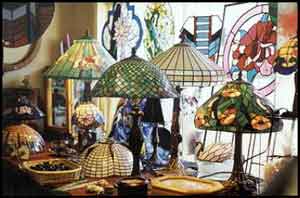|
There are
many good reasons for the student to study the history of stained glass. To
truly excel, the student should be aware of the romance of the medium.
Moreover, an appreciation of the history of stained glass will foster a
dispassionate, critical approach in the student when appraising stained
glass. Informed observation will free the student's imagination for design,
not to copy but rather to inspire.
In
the beginning…
There
is a mystery to glass: it is a form of matter with gas, liquid and solid
state properties. Glass is most like a super-cooled liquid. It captures
light and glows from within. It is a jewel-like substance made from the most
ordinary materials: sand transformed by fire. Before recorded history, man
learned to make glass and colour it by adding metallic salts and oxides.
These minerals within the glass capture specific portions from the spectrum
of white light allowing the human eye to see various colours. Gold produces
stunning cranberry, cobalt makes blues; silver creates yellows and golds and
copper makes greens and brick red.
The
origins of the first stained glass windows are lost in history. The
technique probably came from jewellery-making and mosaics. Stained glass
windows as we know them, seemed to arise when substantial church building
began. By the 10th century, depictions of Christ and biblical
scenes were found in French and German churches and decorative designs found
in England.
One of the
oldest known examples of multiple pieces of coloured glass used in a window
were unearthed at St. Paul's Monastery in Jarrow, England, founded in 686
AD.
The Gothic
age produced the great cathedrals of Europe and brought a full flowering of
stained glass windows. Churches became taller and lighter, walls thinned and
stained glass was used to fill the increasingly larger openings in them.
Stained glass became the sun filled world outside.
Stained
glass windows are often viewed as translucent pictures. Gothic stained glass
windows are a complex mosaic of bits of coloured glass joined with lead into
an intricate pattern illustrating biblical stories and saints’ lives.
Viewed from the ground, they appear not as pictures but networks of black
lines and coloured light.
How
the Tiffany style came to be…
John
LaFarge and Louis Comfort Tiffany were two American painters who began
experimenting with glass in the 19th century. Contemporaries, but
working independently, they were trying to develop glass that possessed a
wide range of visual effects without painting. They soon became competitors.
LaFarge developed and copyrighted opalescent glass in 1879. Tiffany
popularised it and his name became synonymous with opalescent glass and the
American glass movement. LaFarge and Tiffany used intricate cuts and richly
coloured glass within detailed, flowing designs.

The
process of using thin strips of copper as a substitute for lead came allowed
for intricate sections within windows. Tiffany adapted the technique to
construct lampshades and capitalised on the new innovation of electric
lighting. Tiffany’s customers were wealthy, turn of the century families
including the Vanderbilts and Astors. The Tiffany style prompted many
imitators, and opalescent windows and shades remained popular through the
turn of the century.
Stained
glass, or more appropriately art glass, is all around us today. An explosion
of interest in the last 30 years has give rise to many new and imaginative
forms of this art. The rise of the individual artist, new technologies and
the growing interest in stained glass as a hobby craft have all lead to what
is being called a new golden age in glass. New homes are frequently
embellished with spectacular beveled glass entryways, stained glass bathroom
windows and Tiffany style lampshades. Decorative panels are purchased just
to hang in a sunny window. Marvelous glass pieces adorn tables, walls,
shelves and fill windows. New artists are combining, creating and developing
unique new forms and styles every day.
|





